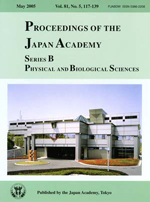巻号一覧

81 巻, 5 号
選択された号の論文の2件中1~2を表示しています
- |<
- <
- 1
- >
- >|
Review
-
Shigeru YAMAGO2005 年 81 巻 5 号 p. 117-128
発行日: 2005年
公開日: 2005/06/24
ジャーナル フリーPolymer-end mimetic organotellurium and organostibine compounds mediate highly controlled living radical polymerizations that allow the molecular weight to be controlled accurately and give well-defined end-groups. A variety of both conjugated (including styrene, acrylate and methacrylate derivatives) and unconjugated monomers (including 1-vinyl-2-pyrrolidinone and vinyl acetate) have been successfully polymerized in a controlled manner. The higher controllability of organotellurium- and organostibine-mediated polymerization compared to organoiodine-mediated polymerization is due to the faster degenerative transfer of organotellanyl and organostibino groups compared to iodine atom. AB-diblock, ABA-triblock and ABC-triblock copolymers have also been synthesized by the successive addition of different families of monomers. Transformations of the end-groups via radical and ionic reactions yielded polymers with a range of different functional groups and well-defined structures.
(Communicated by Hitosi NOZAKI, M.J.A.)
抄録全体を表示PDF形式でダウンロード (638K)
Original Paper
-
Katsushi YOKOYAMA, Masashi SUZUKI2005 年 81 巻 5 号 p. 129-139
発行日: 2005年
公開日: 2005/06/24
ジャーナル フリーFeast/famine regulatory proteins (FFRP) comprise a diverse family of transcription factors. Orthologues of types of eubacterial FFRPs, Lrp, AsnC, YbaO and TinR, were identified. Organisms having these FFRPs were found limited into smaller groups in succession: Lrp in the β and γ subclasses of Proteobacteria, AsnC in the facultatively anaerobic order in the γ subclass, YbaO in the same order in its Vibrionaceae and Enterobacteriaceae families only, and TinR in the species Salmonella enterica in the Enterobacteriaceae family. Yet in a distance map (i.e. an unrooted phylogenetic tree), e.g. TinR did not branch from the YbaO cluster, but the four FFRP groups remained outside to each other. These facts can be explained by assuming duplication of the ancestor gene of ybaO and tinR inside a common ancestor of Vibrionaceae and Enterobacteriaceae. One of the two genes was modified to ybaO, and the other was unused for a number of years until it adapted the new function of tinR inside S. enterica after diversification of Vibrionaceae and Enterobacteriaceae. Using various outgroups, the common root of the four FFRP types was localized to the connection between AsnC and the other three types, so that the second differentiation took place between Lrp and the common ancestor of YbaO and TinR.
(Communicated by Masanori OTSUKA, M.J.A.)
抄録全体を表示PDF形式でダウンロード (915K)
- |<
- <
- 1
- >
- >|